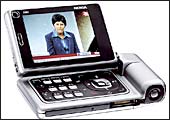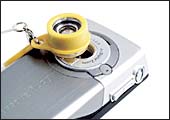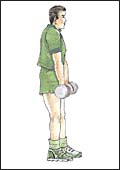|
Of
late I've been getting quite a bit of mail from readers lamenting
the lack of convenient gyms in and around the localities where
they live. And many of them wonder whether they can do strength
training exercises without going to the gym and without the benefit
of lots of equipment. The short answer to that is an emphatic
yes. You don't need a raft of machines to follow an effective
weight training programme. In fact, you can start a progamme with
just two humble dumb-bells, a bench and, perhaps, an exercise
mat.
The dumb-bell is an often overlooked piece
of gym equipment, its versatility either taken for granted or
undervalued. Yet, a pair of dumb-bells can be used for training
almost any muscle group in the body. The obviously easy ones to
target with a dumb-bell are the biceps and triceps (both muscles
of the upper arms)-anyone who has even a nodding acquaintance
with weight training knows biceps (or triceps) exercises that
use dumb-bells. The simple biceps curl is probably the commonest
exercise in weight training.
But dumb-bells can be used for pretty much
any part of the body-you can do bench presses for the chest muscles
using dumb-bells; lateral raises and shoulder presses for your
shoulders; bent-over rows for the back muscles; squats for the
thighs and weighted raises for the calves.... I could go on and
on.
Any sports shop will gladly sell you pairs
of dumb-bells-get two pairs, one light and the other heavy to
begin with. Add a flat wooden or steel bench (with cushioning)
and you're all set. While simple exercises like arm curls are
easily done, it's advisable to get some basic instruction on exercises
for other parts of the body. In this instalment of Treadmill,
let me introduce you to the stiff-legged dead-lift using dumb-bells.
Grab a pair of heavy dumb-bells (as heavy as you can lift 10 times).
Stand straight with the dumb-bells against your thighs and a grip
where your palms face your body. Keeping your back naturally arched
(not hunched over) and your knees straight, bend down from your
hips till your upper body is parallel to the floor. Hold for a
couple of seconds. Now straighten up and get yourself back to
the starting position. That's one repetition of an exercise called
the stiff-legged dead-lift (it's also known as the Romanian dead-lift)
and if you do it right you'll feel a stretch on your hamstring
(at the back of your thighs) muscles and lower back. Do three
sets of 10 reps each.
There, that's one exercise you can do with
just a pair of dumb-bells. Believe me, there are numerous others.
Don't have a gym in your neighbourhood? Just grab a couple of
dumb-bells!
-Muscles
Mani
write to musclesmani@intoday.com
Caveat: The physical exercises described
in Treadmill are not recommendations. Readers should exercise
caution and consult a physician before attempting to follow any
of these.
ALL
ABOUT SPONDYLITIS
If
the digital-age has condemned you to be hunched over your computer
for long hours daily, you need to wise up to the risks. Spondylitis
is one. It's serious because it could be very painful at best
and disabling at worst.
What Is It: Spondylitis is a type
of arthritis that results from inflammation of the spinal joints.
Says Dr K.L. Kalra, Senior Orthopedics Consultant at Sir Ganga
Ram Hospital, "Spondylitis can affect all three regions of
spine-cervical, dorsal and lumbar." The bones of the spine
may grow or fuse together resulting in rigidity. The disease primarily
affects the spine, but other bones, joints and organs can also
become involved. Although spondylitis can occur at any age, it
most often affects men in their 20s and 30s. It is less common
and generally milder in women.
Symptoms: Common symptoms include
frequent pain and stiffness in the lower back and neck. Inflammation
of the spinal cord causes clumsiness in all limb movements. Movements
of the head cause a sensation resembling electric shock. Fusion
affecting bones of the neck, back or hips may impair a person's
ability to perform routine activities. Fusion of the ribs to the
spine may limit a person's ability to expand the chest when taking
a deep breath.
Causes: "Bad posture and a lack
of exercise are the key factors," says Dr Kalra. Researchers
have also found a link between a gene, HLA-B27, and spondylitis.
However, the majority of people carrying this gene don't get spondylitis.
"A desk worker is highly susceptible to the disease."
Excess weight can also contribute to susceptibility to the disease.
Treatment: There is no sure-fire cure,
but the problem can be alleviated to facilitate a normal life.
"Physiotherapy helps," says Dr Kalra. Patients are encouraged
to keep normal postures and sleep on hard surfaces. Exercise is
an essential part of the treatment.
-Manu
Kaushik
PRINTED
CIRCUIT
TV On The Move
Mobile TV
 For
a brief five minutes at the FICCI-frames summit that happened
in Mumbai in late March, I held what could have well been the
future in my hands. Well, what I managed to get my hands on was
a Nokia n92, one of those N-series phones that turns and swivels
in ways that boggle the mind. The phone itself (very nice despite
the twists and the turns) wasn't the thing that could have been
the future; that would have to be the content. You see, I watched
TV on it. I know, Airtel was the first telco in the world to broadcast
a full-length movie and cricket clips and the like are preferred
value added services, but this was TV, live TV. Already, every
major handset vendor in the world-Nokia, Motorola, Samsung, SonyEricsson,
LG, Siemens, BenQ-has a product or two supporting the DVB-H format.
That stands for Digital Video Broadcast Handheld and what it means
is that these phones can pick up broadcast signals (terrestrial
only) with the help of an antenna-meaning that satellite channels
need to be re-broadcast. The reason why I think this could have
been the future but won't be? Actually, there are several. One,
if IPTVFtakes off (and it probably will despite what the Cassandras
say about bandwidth constraints), telcos will find it easy to
push streaming/live video through their networks, and this will
include (if they enter into the right kind of alliances) almost
every channel you currently catch on your TV. Two, most channels
are not terrestrial (in India, for instance, only Doordarshan's
channels are, and in the UK, only BBC's are). Novelty? Yes. Future?
It could have been that, but definitely won't. For
a brief five minutes at the FICCI-frames summit that happened
in Mumbai in late March, I held what could have well been the
future in my hands. Well, what I managed to get my hands on was
a Nokia n92, one of those N-series phones that turns and swivels
in ways that boggle the mind. The phone itself (very nice despite
the twists and the turns) wasn't the thing that could have been
the future; that would have to be the content. You see, I watched
TV on it. I know, Airtel was the first telco in the world to broadcast
a full-length movie and cricket clips and the like are preferred
value added services, but this was TV, live TV. Already, every
major handset vendor in the world-Nokia, Motorola, Samsung, SonyEricsson,
LG, Siemens, BenQ-has a product or two supporting the DVB-H format.
That stands for Digital Video Broadcast Handheld and what it means
is that these phones can pick up broadcast signals (terrestrial
only) with the help of an antenna-meaning that satellite channels
need to be re-broadcast. The reason why I think this could have
been the future but won't be? Actually, there are several. One,
if IPTVFtakes off (and it probably will despite what the Cassandras
say about bandwidth constraints), telcos will find it easy to
push streaming/live video through their networks, and this will
include (if they enter into the right kind of alliances) almost
every channel you currently catch on your TV. Two, most channels
are not terrestrial (in India, for instance, only Doordarshan's
channels are, and in the UK, only BBC's are). Novelty? Yes. Future?
It could have been that, but definitely won't.
 Definitely
Not Stone Age Definitely
Not Stone Age
Motorola PEBL U6
First
came the RAZR, then the SLVR, and now comes the PEBL. With its
brushed-metal complexion and sleek curved looks, this Motorola
phone looks and feels like a pebble you would pick up from a riverbed.
Its coolest feature is a really slick, one finger push that opens
the flap. Motorola India expects to launch this device here by
late April at a price-point around Rs 17,000-18,000.
High-End Thrills
HP Pavilion Media Center
 If
you really, really, really want to watch TV through your computer,
this new machine from hp might be just what you want. It even
has inbuilt Wi-Fi, so that you don't need DSL/cable lines running
through the house. While the Pavilion range starts at Rs 34,990,
this machine with its uber-cool looks, the TV remote and the 17"
LCD monitor costs much more, around Rs 72,000. For that kind of
money, you could get a larger LCD TV. If
you really, really, really want to watch TV through your computer,
this new machine from hp might be just what you want. It even
has inbuilt Wi-Fi, so that you don't need DSL/cable lines running
through the house. While the Pavilion range starts at Rs 34,990,
this machine with its uber-cool looks, the TV remote and the 17"
LCD monitor costs much more, around Rs 72,000. For that kind of
money, you could get a larger LCD TV.
 Magic
Eyes Magic
Eyes
Lenses For Phones
This is straight
out of my wishlist. Gummi lenses is a pack of six stick on lenses
for mobile phone cameras. One lens facilitates close-ups; another
is a wide-angle one; and still another is a kaleidoscope lens
(now, who would need that?). The lenses should make mobile photography
more fun and are available for £26 (Rs 2,028) from www.boysstuff.co.uk.
-Compiled by Kushan Mitra
|






 F
F Definitely
Not Stone Age
Definitely
Not Stone Age If
you really, really, really want to watch TV through your computer,
this new machine from hp might be just what you want. It even
has inbuilt Wi-Fi, so that you don't need DSL/cable lines running
through the house. While the Pavilion range starts at Rs 34,990,
this machine with its uber-cool looks, the TV remote and the 17"
LCD monitor costs much more, around Rs 72,000. For that kind of
money, you could get a larger LCD TV.
If
you really, really, really want to watch TV through your computer,
this new machine from hp might be just what you want. It even
has inbuilt Wi-Fi, so that you don't need DSL/cable lines running
through the house. While the Pavilion range starts at Rs 34,990,
this machine with its uber-cool looks, the TV remote and the 17"
LCD monitor costs much more, around Rs 72,000. For that kind of
money, you could get a larger LCD TV. Magic
Eyes
Magic
Eyes